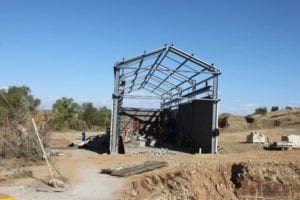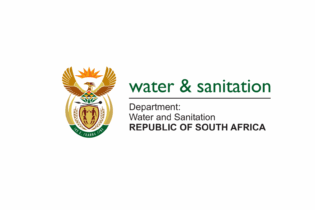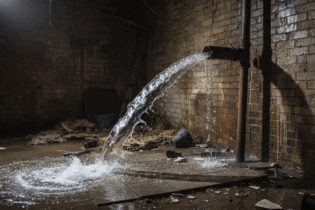The overall progress of the Umsobomvu Local Municipality Bulk Water Supply Scheme reached 77% in March this year and completion is still expected in the second quarter of 2014, Lerato Mokoena, programme manager: Regional Bulk Infrastructure Programme at the DWA, tells Chantelle van Schalkwyk.
The main aim with this Bulk Water Supply Scheme project is to eradicate any existing water backlogs and to ensure sustainable water services to all of the approximately 4 773 households in the Umsobomvu Municipal jurisdiction area of Colesberg – at least until 2030. Lessons learnt According to both Mokoena and the most recent report on the project from the Northern Cape Chief Directorate: Bulk Infrastructure Programme, there were a number of key challenges faced in rolling out this project, waslabour unrest on Phase 2 of the project due to miscommunication between the community liaison officer, the project steering committee and the municipality,which ultimately caused a delay of 4.5 days.A further challenge was in the issuing of a water license and finalising the registration of servitude deeds; however, these were due in part to process and procedure. The lessons learnt thus included that the timely appointment of contractors is extremely important in order to be able to synchronise yearly expenditure and scheme completion, among other things. In addition, the team found that the appointment of a well-qualified and competent contractor is crucial in projects of this nature and that the involvement of too many departmental and seconded personnel providing input to a project can become extremely difficult to manage and consolidate – especially on a project of this size and scale. Despite these hard learned lessons – or possibly as a result of them – the project team will continue with the current programme management methodology to also complete the next phases of this project. Existing infrastructure Colesberg has a population of approximately 17 259 people, with an average of 3.6 people per household. It is estimated that approximately 77% of this community – and the other communities which fall in the Umsobomvu Municipal area – are indigent. In addition, Colesberg relies solely on two sources of water for its supply: the Orange River and groundwater. Currently 3.762 Mℓ/d of raw water is abstracted from the Orange River, while 1.476 Mℓ/d of groundwater is abstracted from borehole fields. Additionally, the existing system that delivers water from the Orange River to the town of Colesberg consists of an abstraction pump station at a deep natural pool in the Orange River that pumps water through a 200 mm diameter pipeline thatis 800 m long to a balancing reservoir at the booster pump station, referred to as the Tolhuis pump station – visible from the bridge on Route 717. The water is measured between the balancing reservoir and the Tolhuis pump station. From there it is pumped by another 200 mm diameter pipeline, 10 223 m long, to another balancing reservoir at Tienmylhoogte booster pump station, from where the raw water is finally pumped to the Colesberg Water Treatment Works (WTW) through another 200 mm diameter pipeline, which is 14 418 m long.The pumping capacity was 41 ℓ/s when the system was upgraded in 1998 and the capacity delivered to the WTW, before the implementation of the RBIG Umsobomvu bulk water supply scheme, is 35 ℓ/sto the WTW.
Field of dreams Potable water is also abstracted from the Van der Waltsfontein well field, home to 11 boreholes, to a collection reservoir at the Van der Waltsfontein pump station, from which it is pumped to the 2.7 Mℓ reservoir. Potable water is also abstracted from a borehole in the centre of town – known as the Trappies dam borehole – to a small collection reservoir before it is pumped to the outlet line of the 2.7 Mℓ reservoir. This 2.7 Mℓ reservoir mainly supplies the Central Town, Lowryville, Towervallei and Industrial area, as well as parts of Kuyasa, as the area of supply interlinks with the Kuyasa network at two locations. According to Mokoena and the report: “The existing surface water infrastructure and groundwater resources for Colesberg are inadequate to meet the demand from the town.” In addition, the PixleykaSeme Feasibility Study indicated that Colesberg had reached a level where there was no spare potable water capacity available, indicating that they had in fact already reached existing water resource insufficiency in 2006. Project breakdown The roll-out of a bulk water supply scheme in itself involves the coordination and implementation of a number of separate projects approached in a phased manner – as is the case with this project. Some of the phases or contracts include the construction of a 4.5 km pipeline between Colesberg and the Orange River, connecting two separate pipelines, as well as a new Tolhuis Pump Station and River Abstraction Point and the upgrading and extension of the Colesberg Water Treatment Works, relating to both civil contracts, and mechanical and electrical contracts. As is the case with the upgrade of the Colesberg Wastewater Treatment Works project, Umsobomvu Local Municipality was added to the Regional Bulk Programme Priority List in 2006.However, it managed to secure funds in 2008 to do an Implementation Readiness Study Report, which was submitted to the DWA in March 2009 and approved by the National team on 18 June 2009. The Regional Bulk Infrastructure Funding Agreement was signed in August 2009, allowing Umsobomvu and the DWA to move forward on project implementation.It was only during the planning phase of this project, however, that the decision was taken to implement it in different phases, namely:- Phase 1: Construction of a 24.8 km pipeline from the Orange River to Colesberg, including the upgrading of the river abstraction and new pump station. This phase was furtherdivided into:
- Phase 1A – 8.0 km pipeline and temporary upgrade of pump station
- Phase 1B – 12.3 km of pipeline, upgrading WTW pumps,
- Phase 1B (LLCs) – 4.5 km pipeline, implemented by 10local learner contractors(LLCs).
- Phase 1C – a new river abstraction works and pump station (civil, mechanical, electrical and electronic works).
- Phase 2: Upgrading and extension of the existing Colesberg Water Treatment Works (WTW).
- Phase 3: Bulk water supply to Noupoort (renamed as Noupoort Bulk Water Supply)
- Phase 1 – upgrading of the existing Noupoort bulk water supply network
- Phase 2 – augmentation of the Noupoort BWS with a new borehole field
- Phase 3 – upgrading/replacement of the Noupoort internal water reticulation network (will not be funded by RBIG).








